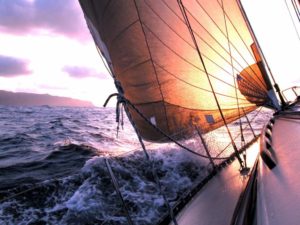Would You Want To Get On This Boat? A Discussion For Correcting The Course of The Design & Construction Industry
-This is the first of a collaborative series: written by John Cribbs & Chase McWhorter at Cedar+Mac
The AEC Industry Can Be Compared To Sailing
Over the course of the next few weeks, we will be analyzing design and construction methods, while also drawing comparisons to another complicated task: sailing.
 Construction projects can be likened to sailing across the ocean. Yes, there are better ways to travel across the ocean like motorized boats, but sailing is still an economical, proven way to navigate the ocean and for this exercise, sailing is the best analogy due to construction still relying heavily on human labor. To further elaborate on this transportation analogy looking at it from a timeline perspective, construction has moved past the 50-man rowing crews of antiquity, and figured out how to master sailing in order to maximize human labor, but engines are not yet economical. Engines can be likened to robots for construction. The technology exists, but the cost is too expensive and unreliable.
Construction projects can be likened to sailing across the ocean. Yes, there are better ways to travel across the ocean like motorized boats, but sailing is still an economical, proven way to navigate the ocean and for this exercise, sailing is the best analogy due to construction still relying heavily on human labor. To further elaborate on this transportation analogy looking at it from a timeline perspective, construction has moved past the 50-man rowing crews of antiquity, and figured out how to master sailing in order to maximize human labor, but engines are not yet economical. Engines can be likened to robots for construction. The technology exists, but the cost is too expensive and unreliable.
Transoceanic sailing also has many of the same elements that can cause delays. For example, the ocean presents many unforeseen conditions much like construction, and both endeavors require managing various groups efficiently to arrive at your final destination safely, on time and within budget. Although engines are too expensive in this analogy, other smaller technologies like GPS and cell phones are accessible and affordable. The point of this analogy is to help explain that although construction must still apply old, proven methods since automation methods like robotics and 3D printing are not economical, there are some technologies that can help improve efficiency when applied correctly without breaking the bank.
The objective in construction is to get from Point A (existing condition) to Point B (finished building). The objective for sailing is also to go from Point A to Point B, and in this analogy our team is going from London to New York. In regards to the team, below is a breakdown of team members in large construction projects and their corresponding ship mate.
Property Owner = Ship Owner
Architect = First Mate (expert map creator)
Engineer = Second Mate (designing and maintaining sails and rudder)
Contractor = First Mate (crew procurement & sailing logistics, or helmsman)
Sub-Contractors = Deckhands (executing the daily work)
Captain = Program Management or Project Management or Construction Management
Program Management = Owner has minimal involvement relying on maximum expertise
Project Management = Owner is involved in procurement and team assemblage as well as design & construction direction
Construction Management = Owner has maximum involvement in decision-making
This is where the foundation is laid for a voyage at sea. How does the owner want his voyage managed? Do they want a Captain to handle every aspect from team assembly to managing day-to-day or does the owner even want a Captain? This is the first decision that must be made from an owner’s standpoint.



